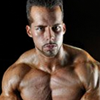
Stubborn Muscle Hypertrophy Workouts
 Table Of Contents:
Table Of Contents:
- Chapter 1 - Introduction
- Chapter 2 - What is Skeletal Muscle Hypertrophy?
- Chapter 3 - Specialized Chest Hypertrophy Workout
- Chapter 4 - Specialized Back Hypertrophy Workout
- Chapter 5 - Specialized Arm Hypertrophy Workout
- Chapter 6 - Specialized Leg Hypertrophy Workout
- Chapter 7 - Specialized Delt & Trap Hypertrophy Workout
- Chapter 8 - Specialized Calf Hypertrophy Workout
- Chapter 9 - Ab Training during a Stubborn Muscle Hypertrophy Routine
- Chapter 10 - Cardio during a Stubborn Muscle Hypertrophy Routine
- Chapter 11 - Nutrition for a Stubborn Muscle Hypertrophy Program
- Chapter 12 - Workout Nutrition/Supplementation
- Chapter 13 - Conclusion

Chapter 1
Introduction
As bodybuilders and physique enthusiasts, we strive to create a symmetrical, proportional physique. During the quest of building such a physique, it is common to have muscles that are lagging in development compared to the rest of the body. In order to bring these lagging muscles' development up to match the rest of the body's development, they must receive focused, intense training.
This book will lay out training routines specifically created to bring up lagging muscles' development. So if you have a muscle group you need to bring up, READ ON!
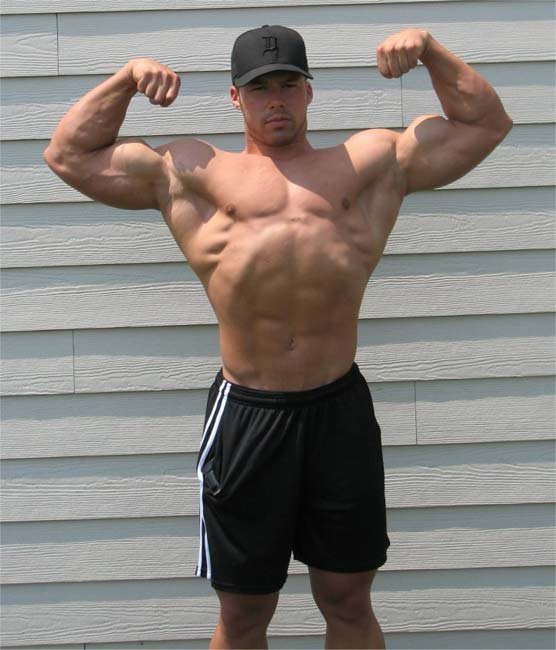
The workout routines in this book are based on data from scientific literature as well as anecdotal feedback and results. These routines have not only been validated by science, but they have also been notarized by myself and many of my clients who have added quality mass to their bodies and made their former "weak points" into one of their most bragged about muscle groups.
These routines are not meant to all be done at once, rather you should pick one or two of the muscle groups to focus on while adjusting or leaving the workouts for the other muscle groups the same to allow for adequate recovery of the muscles you are focusing on increasing in size. That is not to say that one cannot increase the size of all the muscles groups at the same time, but these routines are specifically designed to bring up lagging muscle groups. Also, prioritizing too many muscle groups may lead to fatigue and overtraining. With that said, on to HYPERTROPHY!

Chapter 2
What Is Skeletal Muscle Hypertrophy?
Skeletal muscle hypertrophy is an increase in a muscle's cross-sectional area (CSA). Skeletal muscle hypertrophy is governed by a host of hormones and growth factors, including satellite cells, testosterone, IGF-I, IL-1 & IL-6, to name just a few. An increase in muscle CSA is accomplished by:
- Increase in the size of myofibrils.
Incorporation of new contractile proteins into the Actin and Myosin filaments.
Incorporation of new proteins to the structural filaments - Increase in Sarcoplasm
- Increase in the connective tissues surrounding the muscle, myofibrils and muscle fibers.
An increase in CSA can be accomplished by two forms of hypertrophy: sarcomere and sarcoplasmic.
1. Sarcomere Hypertrophy: Incorporate Of New Proteins In Actin & Myosin
Sarcomere hypertrophy is an enlargement of a muscle fiber as a result of an increase in sarcomere number and size. Sarcomeres, which contain the contractile proteins actin and myosin are the "functional units" of myofibrils.
The incorporation of new contractile proteins into Actin and Myosin filaments increases a muscle fiber's size and ability to produce force, commonly referred to as strength. These new proteins must be created through the process of protein synthesis.
2. Sarcoplasmic Hypertrophy: Increase In Sarcoplasm & Connective Tissue
Sarcoplasmic hypertrophy is an increase of the sarcoplasm (muscle fiber semifluid cytoplasm) and noncontractile proteins. The fiber's ability to produce force does not increase from sarcoplasmic hypertrophy.
The emerging theory behind skeletal muscle hypertrophy is that a bout of exercise causes protein degradation or damage (myotrauma), which leads to a period of enhanced protein synthesis or supercompensation when the bout ceases (Zatsiorsky, 1995). This increase in protein synthesis not only repairs the damage from the bout of exercise, but also makes the muscle stronger and therefore more resistant to future damage. The steps involved in muscle hypertrophy are:
Mechanical Stimuli  Cell Damage
Cell Damage  Cell 'Clean Up'
Cell 'Clean Up'
 Cell Repair
Cell Repair  Cell Growth
Cell Growth
We are not doing to discuss the steps involved in skeletal muscle hypertrophy, just how to stimulate it with weight training workouts. We will go over each muscle group and a workout designed specifically for each muscle group.

Chapter 3
Specialized Chest Hypertrophy Workout

 Structure & Function: Muscles Of The Chest:
Structure & Function: Muscles Of The Chest:
Pectoralis Major (Pecs):
The pectoralis major is the large fan-shaped muscle covering the anterior rib cage. Some people are confused about this muscle as they believe there is an "outer" and "inner" pectoralis muscle.
This classification is anatomically incorrect. But there is an "upper" and "lower" portion of the pectoralis major. The larger sternal head of the pectoralis major, which originates from the sternum, is the "lower" portion of the pectoralis major and the smaller clavicular head, which originates from the clavicle, is the "upper" portion. This separation is anatomically correct since each of these two heads has a distinct action. Both heads insert on the humerus.
The action of the pectoralis major as a whole (both heads working together) is to adduct the arm and bring it medially across the chest (like when you are hugging someone) as well as medially rotate the arm. The clavicular head flexes the arm and the sternal head extends it. Extension of the arm by the sternal head can only occur if the arm is flexed; the sternal head cannot hyperextend the arm.
Pectoralis Minor:
The pectoralis minor is a small, triangular muscle, which lies deep to the pectoralis major. It originates from the anterior surface of the 3-5 ribs and inserts on the coracoid process of the scapula. The pectoralis minor's actions include depression and downward rotation of the scapula.
The Program:
Chest Workout (Done two days a week, i.e. Monday and Thursday)
- Bench Press: 3 X 3-5
- Incline Bench: 3 X 6-10
- Flyes/Cross-overs: 3-6* X 10-12
*Depending on your recovery needs, you should do 1 or 2 sets for each angle.
Total Sets: 9-12
**All sets are stopped 1 rep shy of failure. Training just shy of failure will improve your recovery time and allow you to train your chest more frequently.

 Bench Press:
Bench Press:
I never really focused on bench press until a few years ago. Everyone always said, "If your chest won't grow, focus on dumbbell presses." Well I did that and still did not see the progress I would have liked.
I began bench pressing in the 3-5 rep range and suddenly my chest started to grow. Why? Because I was pressing much more weight than I could when using dumbbells. I also started to use a little wider grip than before, which helps to increase the recruitment of my chest while decreasing the recruitment of my deltoids and triceps.
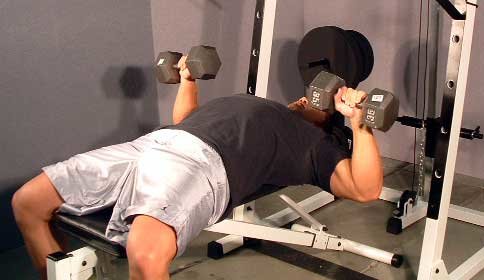
This simple change in grip width completely changed the stimulus I received from bench pressing. I only changed my grip because my left elbow was bothering me when I used my grip width I normally did. So I widened it and BOOM, my chest loved it. Heavy bench pressing is IMO vital for building a massive chest.

The question my clients ask me the most is, "When should I increase the weight for the exercise?" I do not increase the weight on my bench press until I complete 3 sets of 5 reps. For example, today I benched 365 for 3 sets of 3 reps. Once I can bench 365 for 3 sets of 5 I will increase the weight to 375. The reason I wait until I can complete the given reps for all three sets instead of just one set is it pretty much ensures consistent progress.
In the past when I would increase the weight I used more frequently, I would often get stuck at a weight for weeks. For example, when I was trying to work my way up to 315 for 3 sets of 3 reps, I was increasing the weight I used when I could complete the first set of 5 reps, the second set of 4 reps, and the first set of 3 reps. I was aiming for 3-5 reps, so when I could complete all sets as just stated, I upped my weight.
While doing this I had a hard time progressing. Not progressing for weeks can be disheartening and frustrating. Thus far, this method of weight progression, waiting until I complete 3 sets of 5 reps has worked well.

 Incline Bench Press:
Incline Bench Press:
The incline bench press targets the often underdeveloped clavicular head of the pecs. Some may feel that you cannot really target the clavicular head of the pecs, but the difference in the origin (sternum vs. clavicle) of the muscle fibers makes it possible.
When doing incline bench, you should lower the bar to the top of your clavicle, focusing on stretching the pecs and then focusing on using your pecs to press the bar up.
One thing that I have found to help the development of my upper chest is to pause (I pause for 3 seconds) when you are in the fully stretched position, but not resting the bar on your chest. This isometric contraction targets the clavicular fibers and allows you to fully recruit them.
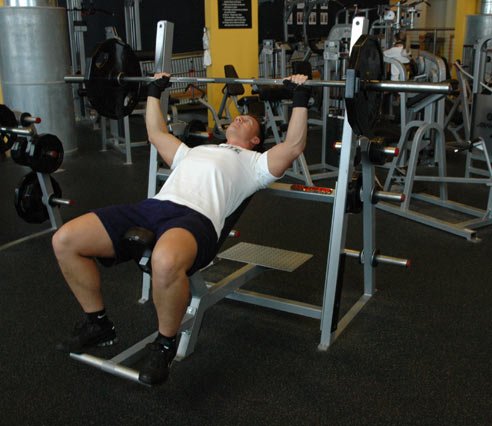
During the concentric portion of the lift, you want to focus on using the clavicular fibers of the pecs and not your deltoids or triceps. In order to fully accomplish this, I would recommend using a lighter load than you would normally press.
Say you can normally do 225 pounds for 6 reps. Drop the weight down to 185 pounds, go for 6 reps, and really focus on the execution of each rep and add in the isometric pause. Unlike bench press where the goal is to use a heavy load and to stimulate the entire chest, incline bench presses focuses on targeting the clavicular fibers of the chest, which are often hard for people to train correctly.

 Flyes/Cable Crossovers:
Flyes/Cable Crossovers:
The final exercise for this routine is DB flyes, cable flyes, or cable crossovers. If you choose to do DB or cable flyes, I recommend doing 1-2 sets of flat flyes, 1-2 sets of incline flyes and 1-2 sets of decline.
If you choose to do cable crossovers, I recommend doing 1-2 sets of high pulley crossovers, 1-2 sets with the pulleys set at shoulder height, and 1-2 sets of low-pulley crossovers. I do not like the term "shaping exercise", so I will just say this setup allows you to hit the pecs for all angles.
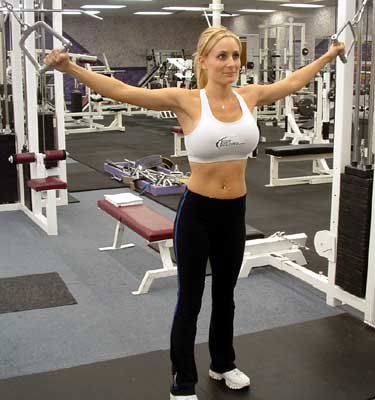
These exercises allow you to fully bring your arms medially across your body, leading to a hard contraction of the pecs. These isolation exercises are done in a higher rep range as ROM and a solid contraction are of prime importance.

 Specialized Chest Routine Options:
Specialized Chest Routine Options:
Chest Specialization Option #1:
- Monday: Chest A + Tris
- Tuesday: Back + Traps + Bis
- Wednesday: Off
- Thursday: Chest B + Delts
- Friday: Legs + Calves
- Saturday: Off
- Sunday: Off
Monday - Chest A + Tris:
Chest A:
- Bench Press: 3 X 3-5
- Incline Bench Press: 3 X 6-10
- Cable Flyes/Crossovers: 3-6 X 10-12
Triceps:
- Close Grip Bench: 3 X 6-10
- Skull Crusher: 3 X 6-10
Tuesday - Back + Traps + Bis:
Back
- Bent Over Row: 3 X 6-10
- Pull-Up or Lat Pulldown: 3 X 6-10
- Seated Cable Row: 3 X 6-10
Traps
- BB Shrug: 3 X 6-10
- DB Shrug: 3 X 6-10
Biceps
- BB Curl: 3 X 6-10
- DB Curl: 3 X 6-10
Thursday - Chest B + Delts:
Chest A
- Bench Press: 3 X 3-5
- Incline Bench Press: 3 X 6-10
- Cable Flyes/Crossovers: 3-6 X 10-12
Delts
- Military or DB Press: 3 X 6-10
- DB Side Lateral: 3 X 6-10
Friday - Legs + Calves:
Legs
- Squats: 3 X 6-10
- Stiff Leg Deadlift: 3 X 6-10
- Leg Extension: 3 X 6-10
- Leg Curl: 3 X 6-10
Calves
- Standing Calf Raise: 3 X 6-10
- Seated Calf Raise: 3 X 6-10
Chest Specialization Option #2:
- Monday: Chest A
- Tuesday: Back + Traps
- Wednesday: Off
- Thursday: Chest B
- Friday: Legs + Calves
- Saturday: Delts + Bis + Tris
- Sunday: Off
Monday - Chest A + Tris:
Chest A
- Bench Press: 3 X 3-5
- Incline Bench Press: 3 X 6-10
- Cable Flyes/Crossovers: 3-6 X 10-12
Tuesday - Back + Traps:
Back
- Bent Over Row: 3 X 6-10
- Pull-Up or Lat Pulldown: 3 X 6-10
- Seated Cable Row: 3 X 6-10
Traps
- BB Shrug: 3 X 6-10
- DB Shrug: 3 X 6-10
Thursday - Chest B:
Chest B
- Bench Press: 3 X 3-5
- Incline Bench Press: 3 X 6-10
- Cable Flyes/Crossovers: 3-6 X 10-12
Friday - Legs:
Legs
- Squats: 3 X 6-10
- Stiff Leg Deadlift: 3 X 6-10
- Leg Extension: 3 X 6-10
- Leg Curl: 3 X 6-10
Calves
- Standing Calf Raise: 3 X 6-10
- Seated Calf Raise: 3 X 6-10
Saturday - Delts + Bis + Tris:
Delts
- Military or DB Press: 3 X 6-10
- DB Side Lateral: 3 X 6-10
Biceps
- BB Curl: 3 X 6-10
- DB Curl: 3 X 6-10
Triceps
- Close Grip Bench: 3 X 6-10
- Skull Crusher: 3 X 6-10
